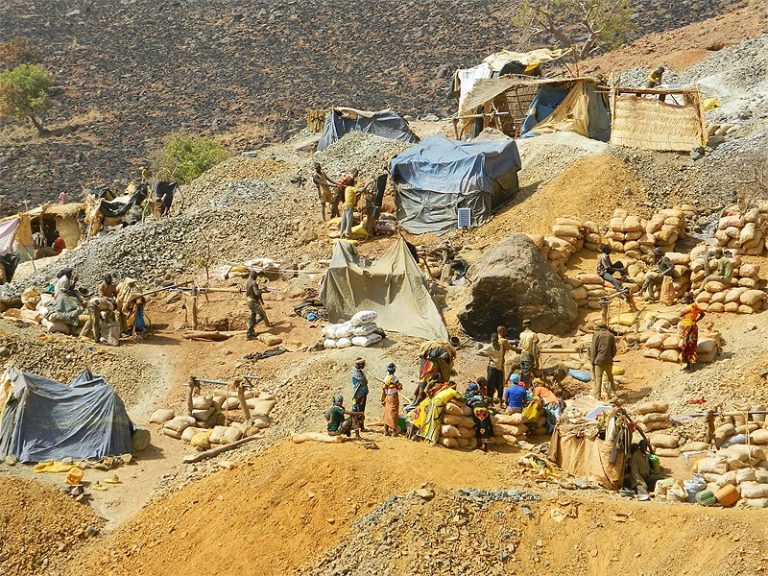The process of rebuilding ISIS in Sahel region depends on gaining the source base in the region for its ops. There are signs that gold sites in the Sahel can become the same financial source as the oilfields in Syria.
Until now, gold sites largely remain a secondary source of funding for jihadist groups in the Sahel. However their reliance on gold could, increase as they expand into other mineral-rich areas, and as they appear to face financing difficulties.
Today the Islamic State in the Greater Sahara is active in Mali and Burkina Faso. A faction of the Boko Haram terrorist group, meanwhile, is in Nigeria, Niger, Chad and Cameroon.

In Mali, Burkina Faso and Niger, a gold boom is attracting the attention of diverse armed groups that are fighting to control gold mining zones in regionsthat the state has neglected or abandoned. Artisanal gold mining provides armed groups with a new source of funding and potentially recruits.
The attacks extend towards hundreds of small-scale mines in Burkina Faso alone. Around 2,200 possible informal gold mines were identified in a government survey of satellite imagery in 2018. About half of them are within 25 km (16 miles) of places where militants have carried out attacks.

Sources: The Armed Conflict Location & Event Data Project (ACLED); National Agency for Management of Mining and Semi‐Mechanized Operations (ANEEMAS); Natural Earth
By Ryan McNeill and Michael Ovaska
In 2018, government officials visited just 24 sites near where attacks had taken place and estimated they produced a total of 727 kg of gold per year – worth about $34 million at current prices.
By taking control of gold mines or securing ore transfer sites and routes, armed groups access a source of financing. This is already the case in the Kidal region (Mali), the stronghold of the Coordination of Azawad Movements (CMA), and to a lesser degree in the Djado area (Niger), home to rebel groups and traffickers moving between Niger, Chad and Libya.
In the Kidal region of Mali, most artisanal gold mines are controlled by members of the CMA or, to a lesser degree, the Algiers Platform of 14 June 2014, an alliance of several dozen pro-government armed groups. Gold is used both to enrich individual combatants and to fund armed movements. The CMA often taxes miners in exchange for site security. Government officials say Islamists are demanding a share of gold produced in the west.
In northern Niger, artisanal gold mining in the Djado area, was quickly seized by networks of several hundreds of armed men, mostly Chadians suspected of links to Zaghawa or Toubou rebel groups from southern Libya. These actors reportedly controlled certain gold sites and illicitly traded gold on Libyan territory until at least 2016.
In the Agadez region of Niger, many mine owners are former rebels or traffickers; Saleh Ibrahim, formerly a rebel of the Niger Movement for Justice (MNJ) and criminal economy baron, has taken up artisanal gold mining at the Tchibarakaten site.
Gold can become a new asset for both financing and recruitment. This risk is increased by the fact that gold miners sometimes do not consider the presence of jihadists a threat but opportunity.
The main jihadist groups in the Sahel benefit financially from gold extraction – an activity that they consider halal(lawful) – in their areas of influence. In Burkina Faso’s Soum province, gold miners pay jihadist groups to secure sites. In the areas of Tinzawaten, Intabzaz and Talahandak, in the north of Mali’s Kidal region, the jihadist group Ansar Dine does not have an armed presence to secure the site, but pays the zakat (religious tax) upon miners and the rest of the population.
In Burkina Faso’s East region, some jihadist groups affiliated with the DAESH in the Greater Sahara (ISGS) also appear to benefit from gold mining by levying the zakat. Despite the recent military operation, they still reportedly control several mining sites, especially in the least accessible forests and reserves, where they likely collaborate with other groups such as some former Koglweogo.
Some miners cooperate with jihadist groups for reasons of pragmatism not conviction: they side with those who hold power at the local level and determine gold mining conditions, or ally themselves with jihadist groups to regain control of disputed mining sites. In the Soum province of Burkina Faso, gold miners reportedly supported jihadists against the Koglweogo who had seized the Kereboulé site in 2016.
In the East region of Burkina Faso, the governor ordered the closure of artisanal mining sites in 2018, officially to cut off sources of funding for terrorist groups. Consequently, disgruntled miners turned toward jihadists, who reopened certain mines, like the one at Kabonga.
Potentially the region of numerous gold sites gives an opportunity to actualize plans of finance ministry of ISIS in 2014 to mint a series of gold, silver, and copper coins for its own currency, to be called Islamic dinars.That time, the ISIS shadowy leader had ordered such coins to be minted as “it is far removed from the tyrannical monetary system that was imposed on the Muslims and was a reason for their enslavement and impoverishment.”









